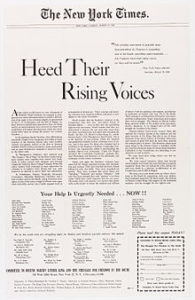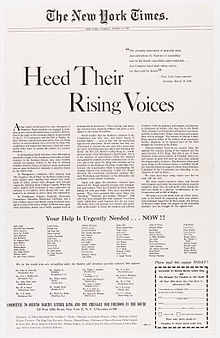Over the course of his 2016 presidential campaign and now as president, Donald Trump has time and again brashly demonstrated his dislike of the media by threatening to limit the freedom of the press and labeling news organizations’ meticulous investigative reporting as “fake news.” Needless to say, the Trump Administration has a turbulent relationship with the press. In an effort to defend themselves and to carry out the duty of a journalist to uncover the truth, many journalists and news platforms have tasked themselves with scrutinizing Trump for his many missteps and controversial actions.
The right for journalists to investigate Trump and write about him is guaranteed by two irrefutable rights granted in the First Amendment of the U.S. Bill of Rights—freedom of speech and of the press. Yet under the Trump Administration, these rights are being challenged, even threatened. To discredit the media, Trump has coined the phrases “fake news” and the “dishonest press” to describe his deep-seated disdain for any media organization or individual that disagrees with his assertions of fact or policies.
Donald Trump began his campaign to malign the media and its “fake news” at a rally in Fort Worth, Texas on February 24, 2016. He spoke about “opening up libel laws.” He insinuated that he would like to change these laws so he can easily sue news organizations and “win money” if they write something unflattering about him. If he could successfully modify these laws he would strip journalists of their security to write candidly, whether writing a factual news articles or an op/ed even if they write fact. Trump would revoke a right central to American journalism and to all Americans.
The laws that are set in place now give public figures, including politicians, the right to sue media organizations only if they have evidence that the article in question was produced with the intent of malice, a ruling decided during the 1964 New York Times versus Sullivan Supreme Court case. This case arose when the Committee to Defend Dr. Martin Luther King Jr., a coalition of Civil Rights activists, published, on March 29, 1960, a full-page ad in the New York Times entitled “Heed Their Rising Voices.” The advertisement condemned the police violence that was taking place against black students who were peacefully “sitting in” at racially segregated lunch counters in Alabama. The primary objective of the ad was to solicit donations to pay for the legal costs required to defend Dr. King against a criminal indictment for supposed tax evasion filed against him by the state of Alabama. An entirely white jury acquitted King in April 1960.

In response to the ad, Montgomery’s police commissioner L.B. Sullivan sued the New York Times as well as Dr. King and various leaders of the Southern Christian Leadership Conference for libel. The ad didn’t use Sullivan’s name, but Sullivan claimed that there were factual inaccuracies about the actions of the police in the advertisement and implications that defaced his reputation as Police Commissioner. In the Alabama state court, Sullivan won his case and the New York Times was mandated to pay $500,000 dollars in reparations. The Times appealed the decision to the Supreme Court, claiming that they had no intention of targeting Sullivan. The Supreme Court unanimously ruled in favor of New York Times, and reinforced the media’s right to truthfully criticize public figures without repercussions. The Court ruled that in order to prove libel a “public official” must show that the newspaper acted “with ‘actual malice’—that is, with knowledge that it was false or with reckless disregard” for the truth. The opinion was written by Justice William Brennan.
In order to change libel laws, Trump would have to go through the strenuous process of either altering the First Amendment of the Constitution or appealing it to the Supreme Court to try and get the 1964 ruling overturned. Whether Trump follows through with his vows, it is a possibility that keeps journalists on edge as they have always relied on their fundamental freedom that allows them to report without restrictions, and without the threat of retribution.
Sean Spicer, Trump’s press secretary, has deliberately maintained Trump’s tumultuous relationship with the press. Spicer has fought the media since his first days as the White House press secretary. During his first press briefing, Spicer addressed Trump’s allegations that the attendance at Trump’s inauguration exceeded that of Barack Obama’s. Trump and Spicer claimed that the press’ “photographs of the inaugural proceedings were intentionally framed in a way to minimize the enormous support that had gathered on the National Mall.” Spicer alleged that the “floor coverings had the effect of highlighting any areas where people weren’t standing while in years past the grass eliminated this visual.” Without any evidence, Spicer repeatedly claimed that it was “the largest audience to ever witness an inauguration.” This was a blatant lie. CNN reported that Barack Obama’s 2009 inauguration attracted a historic 1.8 million people, while only 300,000 to 600,000 people attended Trump’s. However, in true Trump manner, rather than acknowledging their mistake, Kellyanne Conway, one of Trump’s advisors, denied that Spicer had lied. She argued that he had only given “alternative facts,” about the number of people at the inauguration, a phrase that now reads as a shorthand for falsehoods.

Spicer has continued to stubbornly spin the truth to make Trump’s failures look like successes. For instance, there was a military raid in Yemen on January 29, 2017 that resulted in the death of one Navy SEAL, wounded three others, and killed Yemeni civilians. Spicer called this raid an “absolute success.” Only a week before on February 1, 2017 at a press briefing, Spicer said that one “can’t call something a success if someone is hurt.”
Given the Trump Administration’s troubled relationship with, frankly, telling the truth, his accusations of dishonesty in the media are quite ironic. In a now infamous tweet, for example, he said that “the FAKE NEWS media (failing @nytimes, @NBCNews, @ABC, @CBS, @CNN)… is the enemy of the American People!”
It is essential to clarify that these news organizations, who may criticize Trump in their coverage, are not “fake news.” Factual stories like those outlining the Trump Administration’s potential ties with Russia are not fake news. Fake news is comprised of stories that rely on false information, or are deliberately intended to mislead a reader. Critical stories, or even biased ones, are not fake stories.
A mature, receptive consumer of the news can not dismiss stories as untrue simply because they express ideas that they dislike. Shutting our ears to viewpoints that contrast with our own undermines the basic purpose of the freedom of press—to publicize all stories and opinions, regardless of whether an individual might disagree with them.
Recognizing the difference between bias and falsehood is not just important for those who may ignore anti-Trump sentiments either, but also to many Democrats. Liberals should not dismiss Fox News or other conservative-leaning organizations as “fake news” simply because of an opposing bias they perceive within their coverage. Investigate sources for facts when determining whether a source is fake.
As the Trump Administration continues to present false information, like about the attendance of Trump’s inauguration, and enacts executive orders that will negatively impact many around the world, like his travel ban or the rollback on clean air initiatives, the media has been busy counteracting misinformation and criticizing Trump’s actions. As a result, a fair majority of news organizations like the New York Times, CNN, or ABC have likely spent more time criticizing Trump’s actions than praising him.
The media’s continuous criticism and fact checking of the Trump administration is entirely justified, but the imbalance between positive and negative coverage about Trump has left some to accuse the mainstream media of bias. In a rally in Portsmouth, N.H. on October 15, Trump said that “the election is being rigged by corrupt media pushing completely false allegations and outright lies in an effort to elect [Clinton] as president.” In reference to the media’s supposed favoritism, Trump said at another event on October 14 that “the media is, indeed, sick, and it’s making our country sick.” Many Americans shared Trump’s perception of media bias during the election cycle too. A Quinnipiac University poll in mid-october last year during the election showed that 55% of Americans, including 88% of Republicans, believed that the mainstream media was inherently biased against Trump.
Is it criticising Trump to contradict his statements that have been proved untrue? Is it bias to research the impact of Trump’s proposed policies and and present evidence that undermines the President’s assertions.
There is a fundamental, nonpartisan reason for why Trump’s perceived imbalance in coverage does not reflect bias.
The foremost purpose of the freedom of press is to hold people in power accountable for their words and actions. Therefore, criticizing Trump more than praising him is just following the priorities of journalism. It is not bias against him, as the press is merely doing their job by holding him accountable. Consequently, news organizations should not run critical stories less frequently in an attempt to be unbiased, or to appear more nonpartisan.
Yet if the media’s primary goal is to educate people on matters that may affect them, Trump’s noteworthy actions should be covered too.
For example, on February 28, Trump signed the Inspiring the Next Space Pioneers, Innovators, Researchers, and Explorers (INSPIRE) Women Act, which was sponsored by Virginia’s Barbara Comstock (R), an action that got little to no attention in the media. The bill pushes the administrator of NASA to continue exploring new programs that will involve more women in STEM fields. It also instructs NASA’s administrator to report to two senate committees within the next 90 days about increasing engagemen with K-12 STEM students. Particularly, it focuses on bringing astronauts and other experts into mentorship programs for students. On the same day, Trump signed another bill tackling the gender gap in the STEM fields, the Promoting Women in Entrepreneurship Act. The bill is perhaps less influential than the INSPIRE Women Act, but still promotes positive steps towards gender equality in STEM. It encourages the creation of programs to recruit and support women not only in STEM fields, but in the fields of entrepreneurship and commerce as well.
Of course, Trump did not author either of these bills, and his past comments about women and gender equality have been nothing but appalling. Trump has also proposed cuts to STEM funding, reducing the budgets of NASA, the EPA, and the National Science Foundation. However, these acts provide an important exception to Trump’s attack on science and STEM research, and will likely make a significant difference in narrowing the gender gap in STEM fields. While Trump is certainly not a proponent of women’s rights, in these instances he did not actively oppose measures that promote positive change in gender equality either. These bills demonstrate that steps towards gender equality are still possible under the Trump Administration.
Yet despite the tangible change and symbolically positive messages that these bills represent, they got virtually zero coverage from the media. Maintaining neutrality and nonpartisanship within the media relies on covering all stories that are important to the American people, both negative and positive. As aforementioned, there does not need to be an equal amount of positive and negative coverage for Trump. Criticising and scrutinizing people in power is always the foremost concern of the press, and should never be ignored for the sake of trying to appear less biased.
But in order for the press to maintain fundamental neutrality for the next four years, the media must not only criticize Trump when applicable, but report when the government fosters positive change, as well.
Co-written by Liv Jenks and Eddie Dilworth






